Disclosure: This post may contain affiliate links, meaning I get a commission if you decide to make a purchase through my links, at no extra cost to you.
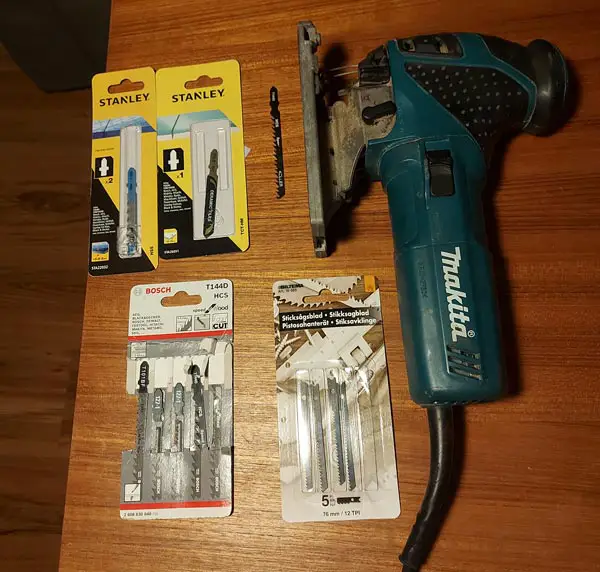
Changing a jigsaw blade is really simple for most jigsaw models, and you can do it in about 5 seconds. But some older jigsaw models do have some complicated ways to change a blade without it being too obvious how to do it. For modern jigsaws, you can just do the following to change the blade.
Jigsaws that use a T-shank blade usually have a lever just above the jigsaw blade. To change the blade we simply pull this lever, which will turn the blade slot 45 degrees. Now you can remove the blade from the slot. Hold the lever in the 45-degree position and insert the new blade all the way in and release the lever.
The example above will be the case for most of you reading this article, but for some jigsaws, it is different. For some older bosch models, there is even a 4″ deep skinny hole you have to insert your screwdriver into to change the blade.
Let’s go through all the methods of changing a jigsaw blade. In an order starting with the obvious, then the not-so-obvious, and at last the absolutely ridiculous methods.
But first, we have to find out what type of blade your jigsaw can use.
T-Shank Or U-Shank
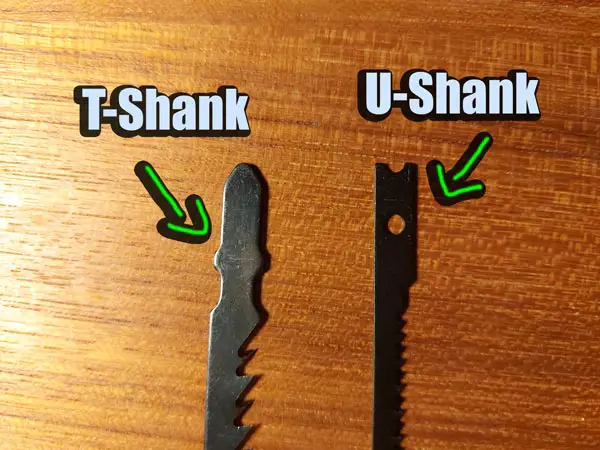
Jigsaw either uses a T-Shank blade or a U-shank Blade. The T-shank is the industry standard now. Generally, jigsaws that use T-shank blades can not use U-Shank blades and jigsaws that use U-shank blades can not use T-shank blades.
A U-shank jigsaw will sometimes be able to secure a T-shank blade in the holder and vice versa. And you will be able to cut with it. But it isn’t optimal and the cuts are going to be worse than if the right blade was used.
T-shank blades have a tighter fit than U-shank blades, they vibrate less, and are often easier to change.
T-shank blades have a shank shape similar to a T.
U-Shank Blades have a shank shape similar to a T.
To determine if your jigsaw uses a T-shank or U-shank blade you can look at the blade that is in your jigsaw right now, check the default blade that came with the jigsaw, or look in the manual for the jigsaw.
It will most likely be a T-shank blade.
How To Change A T-Shank Blade On A Modern Jigsaw
Now, by a modern jigsaw, I mean any jigsaw made in the 21 century. On these jigsaws, it will be simple to change the blade. They have a quick-release system that does most of the job for you.
1. Locate The Lever
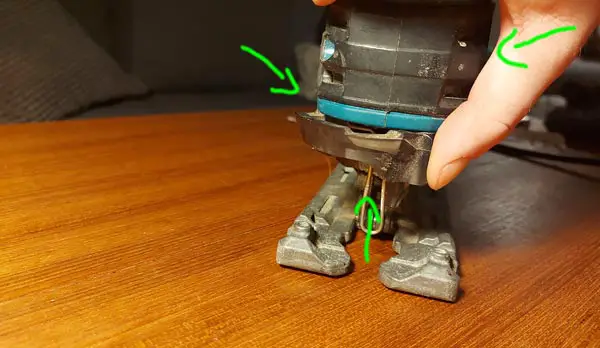
The lever might be in different places depending on the jigsaw. On my Makita jigsaw, it is right above the blade holder.
On some jigsaws, the lever is placed on the right or the left side of the jigsaw.
On others, the blade holder itself is the lever you have to turn. And is a little bit harder to access, but the concept is the same.
Some jigsaws can use a quick-release system where you have to pull the blade holder towards you when you want to change the blade. You have to do the same when you want to insert the new blade.
2. Pull The Lever
To release the blade we need to pull the lever or twist it about 45 degrees. This will turn the blade holder and the blade will come loose.
3. Remove Jigsaw Blade
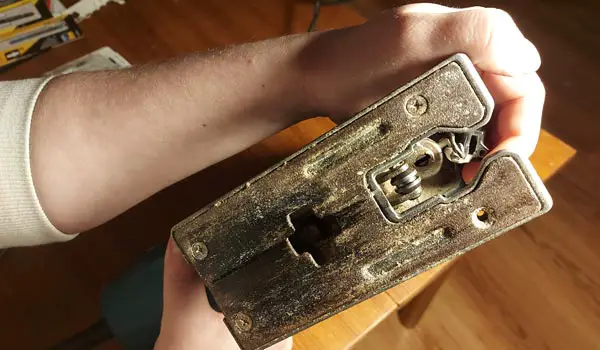
Keep the lever at 45 degrees and pull out your jigsaw blade. It should come out without using any force.
Some jigsaw blade changing systems are spring-loaded. If so, the jigsaw blade will jump out on its own when you turn the lever.
I do not really like these spring-loaded systems. Sometimes the spring has too much tension, and the blade will come shooting out and land somewhere in the room.
4. Insert Jigsaw Blade
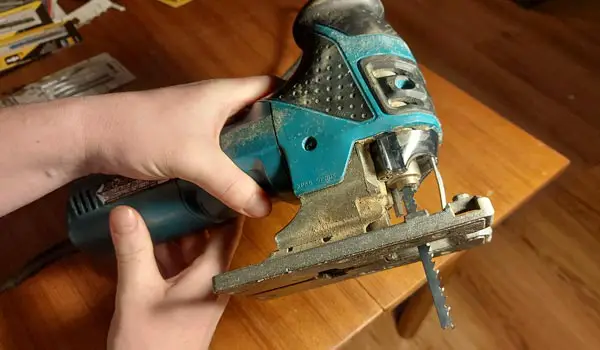
While still holding the lever at about 45 degrees, insert the jigsaw blade with the teeth facing away from the jigsaw.
Put it in as far as it can go without using force and slowly release the lever.
Now the blade should settle in tight and is automatically straightened.
5. Line Up Roller And Blade
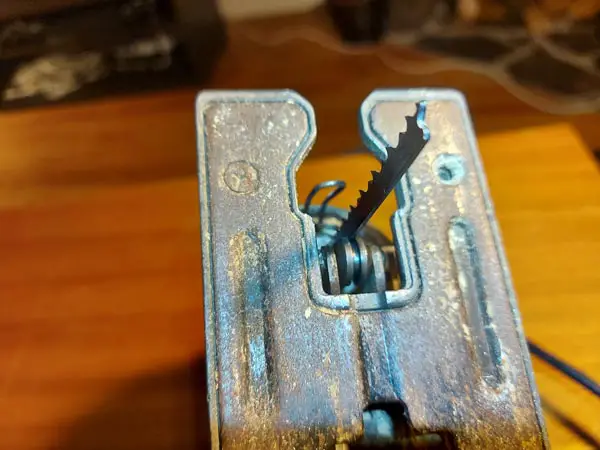
It is important that Jigsaw sits up against the roller guide, and that it is in the center of it.
I usually turn the jigsaw upside down to check that blade is securely placed and looks straight.
With the power turned off, you can also pull the jigsaw blade a couple of times to make sure that it is tight and does not come loose.
6. Common Problems
A common problem with jigsaws is that the blade keeps fallout out while cutting. Some jigsaw models have a poor design that can cause this to happen.
The set screw can also become loose due to the vibration that is created when cutting with a jigsaw. But the set screw problem is more relevant to the upcoming way to change a jigsaw blade.
Jigsaw blades can become crooked after use, this usually happens if you use too much force during the cut, you have a dull blade or you hit something hard like a nail during the cut.
When you have a crooked jigsaw blade you should change the blade, or you can try to straighten it with a vice.
How to change T-Shank/U- Shank Jigsaw Blade With Set Screw
The method of changing T-shank and U-shank blades that are secured with a set screw is very similar. So I’m going to join them together.
1. Locate The Set Screw
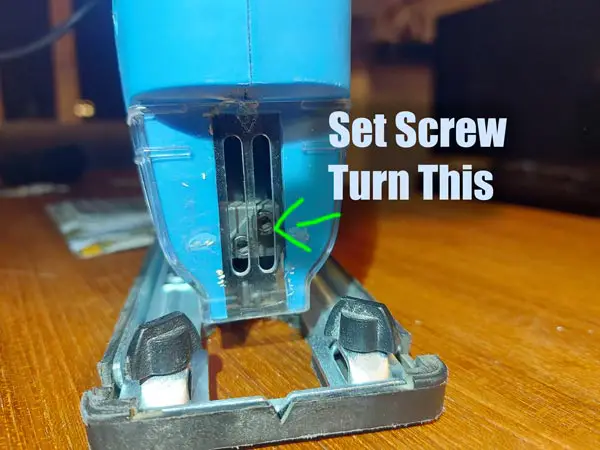
The set screw will either be at the front of the blade holder or on the side of the blade holder. It can either be a flat head screw or an alan head screw.
Some jigsaws use one screw and some jigsaws use two screws.
On some jigsaw models, the set screws are placed behind the blade guard. But there are slots that you can fit the alan key through.
It can also be completely exposed so it is easy to get access.
2. Loosen The Set Screw
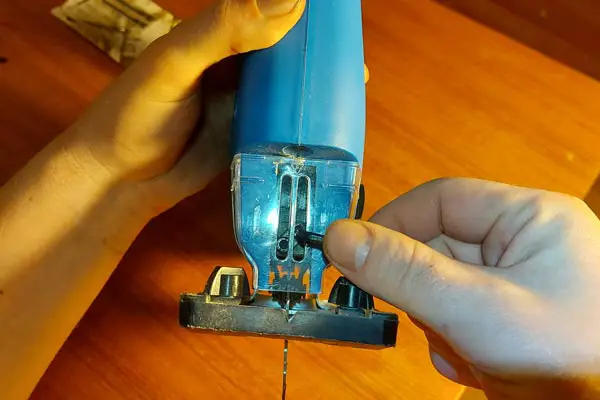
When you have located the set screw, you need to determine what tool you need to use.
But basically, you need a normal flathead screwdriver or a set of alan wrenches.
The tool to change the blade is usually included when you buy the jigsaw.
Just loosen the set screw enough to take out the blade, don’t remove it entirely. It can be a pain to get back in the hole, especially for jigsaws with a blade guard.
3. Take Out The Blade

Remove the blade from the holder.
4. Insert The New Blade

Insert the blade in the blade holder with the teeth facing away from the jigsaw. Push it as far in as it goes without using force, it should slide in without effort.
On T-shank blades that use a set screw, the T part of the shank is supposed to be placed right up to the blade holder. So the two shoulders of the blade are on the outside of the blade holder.
On U-shank blades that use a set screw, you will just push it in as far as it goes.
5. Tighten The Set Screw
Be sure to hold your jigsaw in a way so that the blade does not move while you are tightening the screw.
My tip is to hold it upside down at a slight angle.
6. Check That It Is Straight
After you have finished tightening there is one more thing we have to do before we start cutting.
Make sure the blade is straight, and that it rests on the blade guide that supports the blade.
While the unit is unplugged, try to pull the blade to check if it is secured tightly.
The set screws can become loose after you have used the same blade for a while due to the high vibrations that a jigsaw produces while cutting.
Be sure to tighten the set screws once in a while.
How To Change Jigsaw Blade With No Lever Or Set Screw Visible
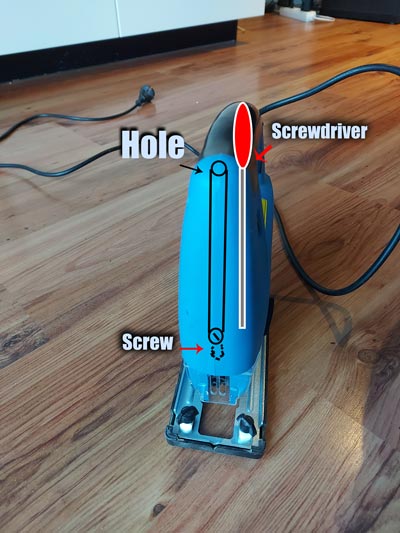
For this last blade change, I am not going to complete a full guide, because it is basically the same method as the one above. But the set screw is hidden.
On some jigsaw models, they have managed to hide the set screw deep down in the tool, in a hole on the top of the tool. I have no idea why they thought this was a good idea, but it is what it is.
An example of a model that uses this type of blade-changing system is the Bosch 1581vs jigsaw. Some other older bosch model also uses this method too. There might be other brands that use this method as well, but I don’t know about them.
Luckily, they have moved away from this method.
The method of changing the blade is the same as with other jigsaws that use a set screw for tightening.
Use a long flathead screwdriver that can into the long hole on the top of the tool, loosen the set screw, remove the blade, insert the new blade and tighten the set screw.
